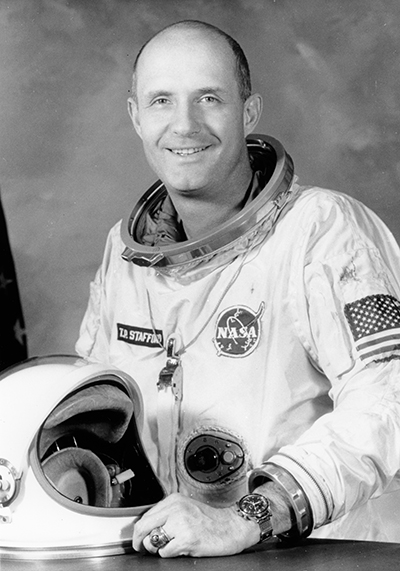The Encyclopedia of Oklahoma History and Culture
STAFFORD, THOMAS PATTEN (1930–2024).
Thomas Patten Stafford's mother arrived at her homestead in western Oklahoma with her parents in a covered wagon before statehood. In 1969 she watched her son live on color television as he orbited the Moon. The true definition of pioneer fits this family and this man. Stafford was born September 17, 1930, in Weatherford, Oklahoma, to the town dentist, Thomas S. Stafford, and his wife, Mary Ellen.
In Weatherford Stafford's interest in flying began as he watched DC-3s pass overhead on flights from East to West coasts. His English and math teachers at Weatherford influenced him in his studies and his future career. The Weatherford High School football captain left for the U.S. Naval Academy after graduation. Finishing in the top 25 percent of his class, Stafford was offered a chance to join the newly formed U.S. Air Force. He always wanted to fly "higher and faster," so his natural progression was to move on to test pilot school at Edwards Air Force Base. Graduating number one in his 1958 class and receiving the award for outstanding student, Stafford was offered a teaching slot at the school. There he co-wrote two textbooks for the trainees.
These events culminated in his appointment on September 17, 1962, as an astronaut with NASA, selected in the second group of astronauts. Stafford made his first flight in December 1965 as pilot on the two-man Gemini 6 flight with Wally Schirra as commander. On this flight they proved with precision the viability of rendezvous in space. This maneuver was critical in order for America to reach the Moon.
Stafford's next flight came in June 1966 on Gemini 9. This time he commanded, with Eugene Cernan as pilot. Again, rendezvous was a critical component of this flight along with a long duration space walk by Cernan. Stafford was truly the rendezvous expert after two Gemini flight rendezvous missions. His experience made Stafford a natural for commanding Apollo 10 in May 1969, along with pilots Cernan and John Young. This flight proved all the components for a Moon landing, including a lunar module trip to within ten miles of the surface. This flight facilitated the first Moon landing, accomplished on the next mission, Apollo 11.
In July 1975 Stafford commanded his final mission on the international Apollo-Soyuz flight, along with pilots Vance Brand and Deke Slayton. This event began the thawing of the Cold War between the United States and the Soviet Union. When Apollo and Soyuz docked, the famous handshake in space was seen live around the world as Stafford and cosmonaut Alexei Leonov met in the open hatch that connected the vehicles.
Stafford left NASA and became commander of the Air Force Flight Test Center in November 1975. After promotion in March 1978 to lieutenant general, Stafford became Air Force Deputy Chief of Staff for Research, Development and Acquisition. He retired from that position in November 1979. Stafford has received the Air Force Distinguished Flying Cross, the Air Force Command Pilot Astronaut Wings, two NASA Distinguished Service Medals, two NASA Exceptional Service Medals, and the Congressional Space Medal of Honor, among numerous other medals and awards. Thomas P. Stafford died on March 18, 2024, in Florida.
See Also
GERALDYN M. COBB, LEROY GORDON COOPER JR., OWEN K. GARRIOTT, WILLIAM REID POGUE, JACKIE LINWOOD RIDLEY, STUART ALLEN ROOSA
Learn More
Dick Lattimer, All We Did Was Fly to the Moon (Gainesville, Fla.: Whispering Eagle Press, 1983).
Citation
The following (as per The Chicago Manual of Style, 17th edition) is the preferred citation for articles:
Bill Moore, “Stafford, Thomas Patten,” The Encyclopedia of Oklahoma History and Culture, https://www.okhistory.org/publications/enc/entry?entry=ST011.
Published January 15, 2010
Last updated March 18, 2024
© Oklahoma Historical Society


